
10 events that helped shape Toronto
During more than 220 years of growth from a little garrison town into a full-fledged megacity of skyscrapers, subways, and highways, the people of Toronto have witnessed numerous events that have profoundly shaped the city we know today. From wild storms and political movements to planning decisions and infrastructure projects, here are 10 events that helped shape Toronto.
The Toronto Purchase
In 1787, the Mississauga First Nations traded a massive swath of land that would eventually form parts of Toronto, Etobicoke, Scarborough, North York, and York Region for "2,000 gun flints, 24 brass kettles, 10 dozen mirrors, 2 dozen laced hats, a bale of flowered flannel, and 96 gallons of rum" worth about $60 in today's money. The deal, which was clarified in 1805, was eventually settled with a $145 million payment in 2012. Without it, it's possible Toronto might never have been founded, at least not here.
The storm that created the Toronto Islands
Before a storm punched a hole in the sandbar that connected the Islands to the mainland, it was possible to walk from the foot of present day Woodbine Ave. to the tip of Hanlan's Point. The spit, naturally formed by material eroded from the Scarborough Bluffs, was popular hunting and fishing location for First Nations people and later a prime piece of real estate for the Toronto's wealthy. It's possible that without natural intervention the Islands might not be islands today at all.
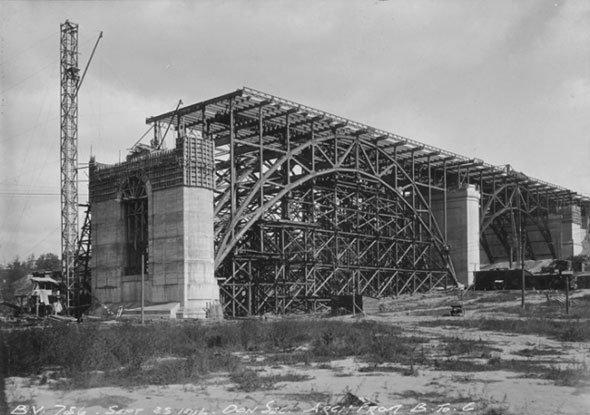
Completion of the Prince Edward Viaduct
One of Toronto's first megaprojects, the linking of west and east via the Bloor Viaduct was a critical moment in the evolution of the city. Before the bridge, which cost $2.5 million and took four years to complete, the Don Valley was still a significant obstacle. Originally carrying auto and streetcar traffic, the bridge closed the gap between east and west and signalled newfound prosperity. Foresighted designers even included a rail deck that would eventually become part of the Bloor-Danforth subway line in the 1960s.
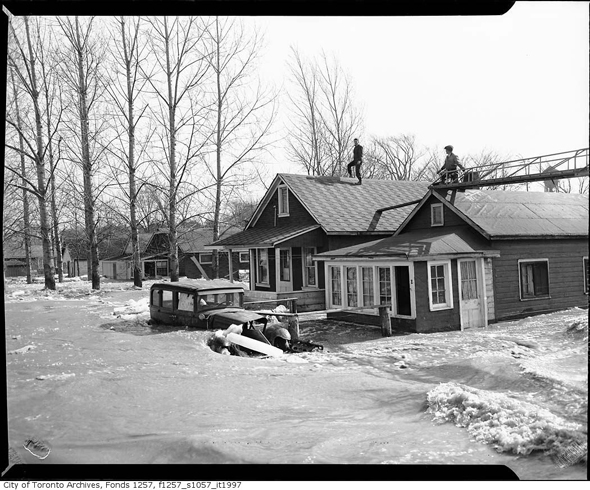
Hurricane Hazel
The hurricane that battered Toronto in 1954 wasn't just memorable for the havoc and destruction it wrought (81 dead and 1,868 homeless,) the aftermath profoundly changed the city's urban planning. Post-Hazel, building on river flood plains was all but eliminated and the Toronto and Region Conservation Authority was formed to managing the GTA's watersheds. Many of our best loved ravine parks are under the stewardship of the TRCA and development-free as a result of Toronto's worst natural disaster.
Amalgamation
Before the "shotgun marriage" of the late 1990s that smooshed together the former boroughs of Toronto and Metropolitan Toronto, the former senior level of local government, the various constituent parts of the city (Etobicoke, North York, Scarborough, and Toronto) elected their own mayors and had a greater say over their own affairs. With amalgamation, some argue, came urban/suburban divide and a city that too big to adequately handle local issues and too small to deal with regional challenges, like transit.
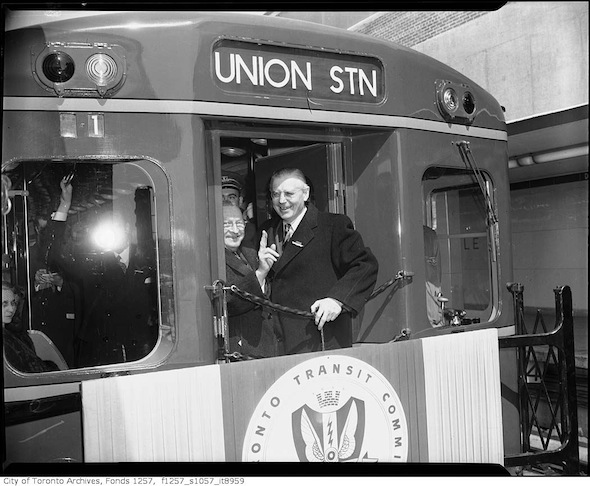
The opening of the Yonge subway line
By building subways, Toronto hoped, the city could finally do away with its streetcars. When the Yonge line opened between Eglinton and Union in 1954, it directly replaced one surface rail route and led to the closure of others on Bay and Church. The St. Clair streetcar was also altered. The city and TTC hoped that all of Toronto's streetcars would be abolished by 1980. They were, in the words of Metro Toronto chairman William Allen, "as obsolete as the horse and buggy." In the ensuing decades, Toronto's sprawling subway dreams were gradually dashed, and streetcars left to become the workhorse of the downtown network.
Opening of New City Hall
Like the Prince Edward Viaduct 47 years before it, Toronto's space age headquarters became more than just a building, it was a symbol of the city's growth. Designed by Finnish architect Viljo Revell, the pair of curved towers, raised "clamshell" council chamber, and sprawling concrete square still look as starkly modern as they it on opening day in 1965. In the years that followed, TD Centre, Commerce Court West, and First Canadian Place would breathe futuristic new life into Toronto's low-rise skyline.
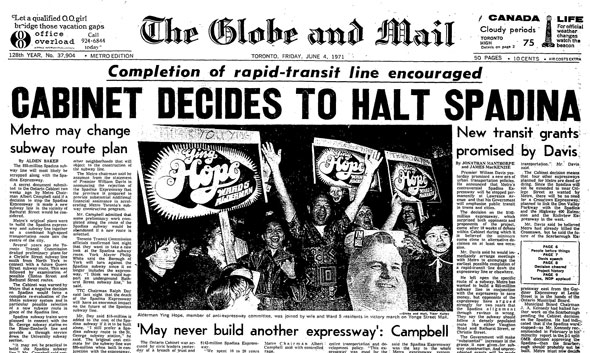
The cancellation of the Spadina Expressway
It's rare that cancelling a major transportation project (especially one that's already under construction) has a demonstrably beneficial effect on a city, but the nixing of the controversial expressway that would have linked Bloor and Spadina with the 401 was clearly a good move. Championed by renowned urbanist Jane Jacobs, the "Stop Spadina Save Our City" movement successfully halted short-sighted urban planning that could have seen some of Toronto's best bits permanently destroyed.
The G20 protests
More than four years later, and the legacy of the largest mass arrest in Canadian history is still unfolding. Over two days in June 2010 during the G20 summit at the Metro Toronto Convention Centre, more than 10,000 people gathered in downtown Toronto to protest poverty, government environmental policies, and the suffering of First Nations people. The riots began when a small group of masked rioters broke away from the main group, smashing windows and setting fires. In the melee, police briefly lost control of the core, deploying tear gas for the first time in the history of the city. In 2013, a police officer was convicted of beating Adam Nobody, an unarmed protester.
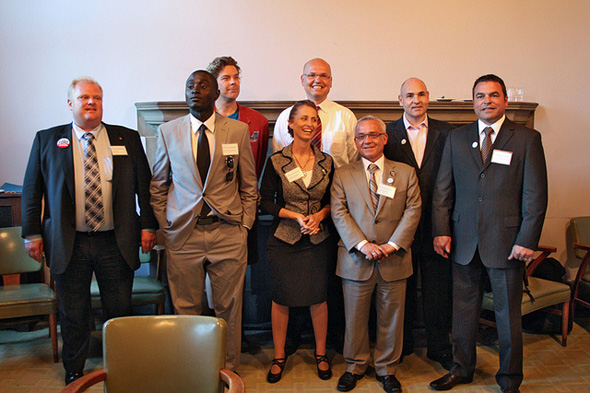
Rob Ford winning the mayoralty
Less than a month into the post-Ford era and it remains to be seen what will be the legacy of the city's most divisive mayor. Elected on a cost-cutting platform, the bombastic city councillor was controversial before his mayoralty descended into a bizarre and protracted drug and alcohol scandal. By upsetting and alienating large swaths of the city, Ford may have actually fostered greater civic engagement in Toronto, but without a doubt the city is a different place politically then it was in 2010.
Chris Bateman is a staff writer at blogTO. Follow him on Twitter at @chrisbateman.
Image: City of Toronto Archives (as marked,) Toronto Public Library. Top photo of G20 by Poyan Pourshianin the blogTO Flickr pool. Photo of 2010 mayoral candidates by Shaun Merritt.
Latest Videos
Latest Videos
Join the conversation Load comments







